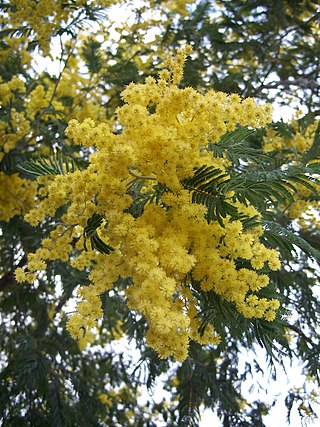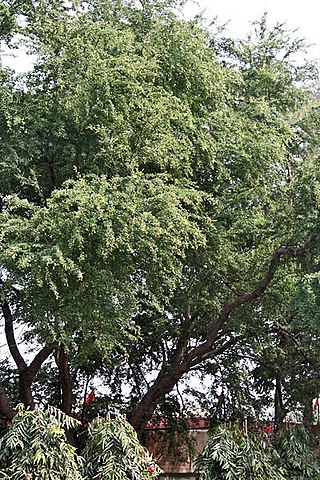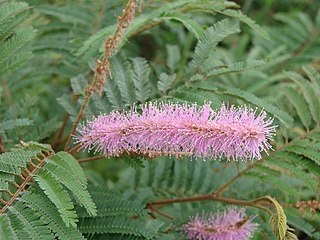
Mimosa is a genus of about 600 species of herbs and shrubs, in the mimosoid clade of the legume family Fabaceae. Species are native to the Americas, from North Dakota to northern Argentina, and to eastern Africa as well as the Indian subcontinent and Indochina. The generic name is derived from the Greek word μῖμος (mimos), an "actor" or "mime", and the feminine suffix -osa, "resembling", suggesting its 'sensitive leaves' which seem to 'mimic conscious life'.

Albizia is a genus of more than 160 species of mostly fast-growing subtropical and tropical trees and shrubs in the subfamily Mimosoideae of the family Fabaceae. The genus is pantropical, occurring in Asia, Africa, Madagascar, America and Australia, but mostly in the Old World tropics. In some locations, some species are considered weeds.

The Niokolo-Koba National Park is a World Heritage Site and natural protected area in south eastern Senegal near the Guinea border. It is served by Niokolo-Koba Airport, an unpaved airstrip.

Mimosa pudica is a creeping annual or perennial flowering plant of the pea/legume family Fabaceae. It is often grown for its curiosity value: the sensitive compound leaves fold inward and droop when touched or shaken and re-open a few minutes later. It is well known for its rapid plant movement. Like a number of other plant species, it undergoes changes in leaf orientation termed "sleep" or nyctinastic movement. The foliage closes during darkness and reopens in light. This was first studied by French scientist Jean-Jacques d'Ortous. In the UK it has gained the Royal Horticultural Society's Award of Garden Merit.

The streak-backed oriole is a medium-sized species of passerine bird from the icterid family. It is native to Central America and Mexico and is an occasional visitor to the United States.

Mimosa pigra, commonly known as the giant sensitive tree, is a species of plant of the genus Mimosa, in the family Fabaceae.

Acacia dealbata, the silver wattle, blue wattle or mimosa, is a species of flowering plant in the legume family Fabaceae, native to southeastern Australia in New South Wales, Victoria, Tasmania, and the Australian Capital Territory, and widely introduced in Mediterranean, warm temperate, and highland tropical landscapes.

Pithecellobium dulce, commonly known as Manila tamarind, Madras thorn, monkeypod tree or camachile, is a species of flowering plant in the pea family, Fabaceae, that is native to the Pacific Coast and adjacent highlands of Mexico, Central America, and northern South America. It is also sometimes known as monkeypod, but that name is also used for several other plants, including Samanea saman. It is an introduced species and extensively naturalized in the Caribbean and Florida, as well as the Philippines and Guam via the Manila galleons. It has also been introduced to Cambodia, Thailand and South Asia, It is considered an invasive species in Hawaii.

Albizia lebbeck is a species of plant in the family Fabaceae, native to the Indian subcontinent and Myanmar. It is widely cultivated and naturalised in other tropical and subtropical regions, including Australia. Common names in English include siris, Indian siris, East Indian walnut, Broome raintree, lebbeck, lebbek tree, frywood, koko and woman's tongue tree. The latter name is a play on the sound the seeds make as they rattle inside the pods. Siris is also a common name of the genus Albizia.

Mimosa diplotricha is a species of leguminous woody shrub native to the Neotropics. It is an invasive species and now has a pantropical distribution. It is commonly known as the giant sensitive plant, giant false sensitive plant, or nila grass.
Pseudalbizzia pistaciifolia is a species of plant in the family Fabaceae. It is found in Colombia, Ecuador, and Venezuela.
Mimosa andina is a species of plant in the family Fabaceae. It is found only in Ecuador. Its natural habitat is subtropical or tropical dry shrubland.
Mimosa disperma is a species of plant in the family Fabaceae. It is found only in Ecuador. Its natural habitat is subtropical or tropical dry forests.
Mimosa loxensis is a species of plant in the family Fabaceae. It is found only in Ecuador. Its natural habitat is subtropical or tropical dry shrubland.
Mimosa nothacacia is a species of plant in the family Fabaceae. It is found in Ecuador and Peru.
Mimosa townsendii is a species of plant in the family Fabaceae. It is found only in Ecuador. Its natural habitat is subtropical or tropical dry shrubland.

Mimosa verrucosa, commonly known as jurema-branca or jurema-de-oeiras, is a species of legume of the genus Mimosa, in the common bean family, Fabaceae.

Archidendron bigeminum is a tree species in the legume family (Fabaceae). It is found in India and Sri Lanka. It is known as "kalitiya - කලටිය" in Sinhala.
Discocharopa is a genus of small air-breathing land snails, terrestrial pulmonate gastropod mollusks in the family Charopidae.

The Oti Valley Faunal Reserve is a protected area in northeastern Togo, one of four Important Bird Areas (IBA) in the country. The site is mainly savanna and seasonally inundated floodplains on either side of the Oti River. It has a total area of 147,840 hectares and is located at 10°35'N and 0°40'E.













